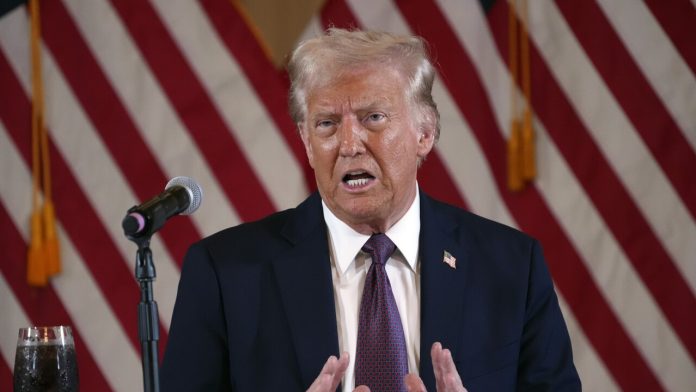Donald Trump president-elect of the United States jumped into setting tariffs with plans of what he calls an “External Revenue Service” which is supposed to be responsible for collecting all manner of duties and tariffs on anything coming from abroad. This, in particular, raises eyebrows and presents concerns in Canada, where officials stack up for the onslaught.
An External Revenue Service by Itself
In a recent post on social media, Trump announced “I am announcing today that I am creating the External Revenue Service to collect our tariffs, duties, and all other revenue that comes from foreign sources.” He said that the new agency is set to open for official business on January 20, 2025-the day of his inauguration. However, the particulars of this announcement are vague.
Questions abound about what it would take to make this agency a reality. Would it require congressional approval? Would it change anything in the current tariff collection regime? At this point, all that remains uncertain is what may happen next and how that would play out in the U.S.
Tariffs as economic policy means Trump would be reinstating the implementation of a 25% tariff on Canadian and Mexican goods if he does not see improvement in border security. The threat somehow stems from his contention of worries about illegal immigration and calls for prohibitions on drugs. There are little snippets of plans, as spoken forth by Canadian officials, on ways to fulfill better border security; however, it is uncertain whether Trump-based or non-Trump-led programs could make a real difference.
Former White House advisor Steve Bannon provided hints into Trump’s inner circle reasoning behind tariffs. He was of the view that the proposed ERS would go beyond traditional tariffs and also bring into consideration ways to charge fees for different facets of foreign access to the American market. The underlying belief here was that foreign entities are not entitled to free access to American resources and markets.
Also read: Top 10 Wealthiest African Countries: Africa’s Rise as the Continent of Millionaires
Understanding the Way Tariffs Work
In order to understand the consequences of the tariff policies of Trump, it is vital to understand how tariffs work. When companies import products into the U.S., they typically pay customs duties to the border patrol, thus impacting the price of an ordinary assortment of consumer products.
All said and done, Trump has always refused to accept the position that tariffs are taxes on Americans country that does not go along is subject to the consequences. With tariffs, he seems mostly to be interested in forcing companies to relocate to the U.S., thus creating jobs in the United States.
Canadian reaction
With the approach of Trump’s inauguration, Canadian officials are intensifying their diplomatic efforts. High-profile meetings are taking place in Washington, D.C., involving Canadian cabinet ministers and American policymakers, with a clear intent to make them aware that tariffs could prove harmful not just for Canadian businesses but also for American consumers, possibly driving up costs.
Some of the Canadian leaders are taking a Team Canada approach in order to make the message heard by the U.S. However, the Canadian political landscape is anything but easy, especially with the resignation of one of the prominent leaders, which casts a shadow of uncertainty over over-representation in negotiations.
Challenges in Organized Responses
The lack of a complete front by Canadian leadership may hamper their ability to negotiate with the incoming Trump administration. Mixed signals from various provincial leaders may raise questions about the benefit of such meetings.
Some analysts argue that Canada should expand its approach to the talks, acknowledging the need for negotiations not only with the American government but also with other representative political actors on the international plane, who share concerns about Trump’s proposed tariff policies.
International Implications
Trump’s proposed tariffs and creation of the ERS may impact foreign nations beyond North America. Since the United States, part of one global trade network, raises tariffs, other nations retaliate with countermeasures, thus creating a setting for trade wars.
Lest one forget, there is a geopolitical dimension to this, for the countries of the world, China and Russia in particular, are plumbing deep subtext beneath the short-term threats. The tariffs raised by Trump may unite those countries in heretofore unseen alliances that would coordinate their interests in response to U.S. economic isolationism.
Economic Consequences of Tariffs
For most of the past century and more, tariffs have been among the most contentious issues of economic policy. The defending view protects domestic industries, while the critics express that they disrupt competition, harm the consumer with higher prices, and invite corresponding tariffs.
In previous tariffs by the Trump administration on steel and aluminum, jobs in the industries dependent on the products were lost. Such situations propose a tightrope that policymakers must walk looking at tariffs as a means of economic strategy.
Road Ahead: What Next?
With Trump on the verge of taking office, many questions remain unresolved in regard to his tariff policies and the ERS formulation. Will Congress approve an agency that further confirms its support for tariffs? How tariffs would work out in a trade relationship between the United States and Canada? What could be the long-term economic effects?
Canadian officials are desperately undertaking measures to alleviate the potential damage from the threatened tariffs proposed by Trump, emphasizing the connection between the two economies. In the coming weeks, both countries will find the situation unfolding.
With Donald Trump’s plans for the External Revenue Service accompanying his commitment to tariffs, the stage seems set for a major shift in U.S. trade policy. As Canada and other nations prepare to grapple with these changes, it will be centered foremost on finding ways to engage diplomatically and protect their economic interests. With high stakes, the outcome of these negotiations may well signal the future course of international trade for years to come.








